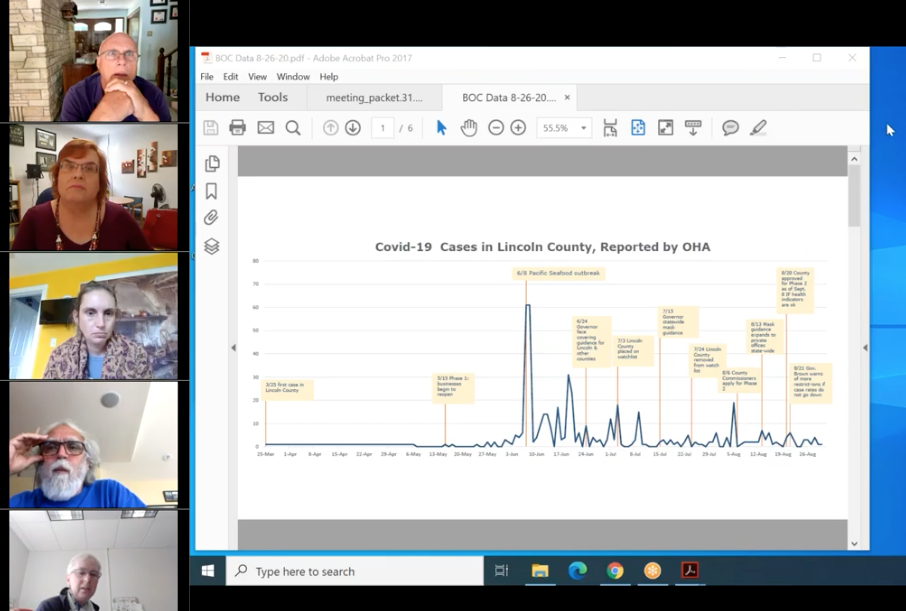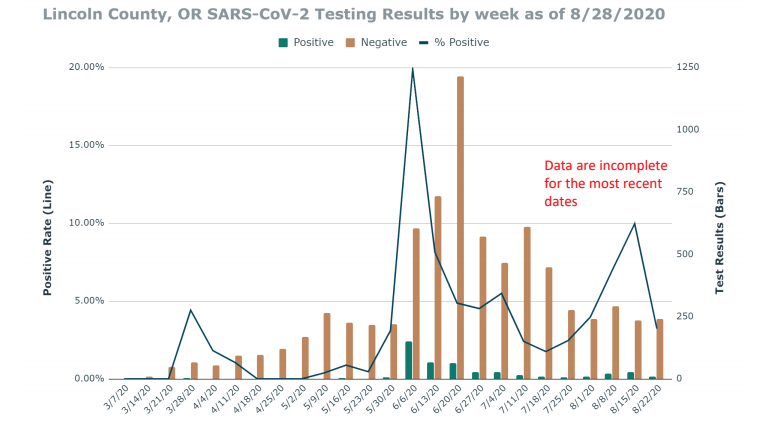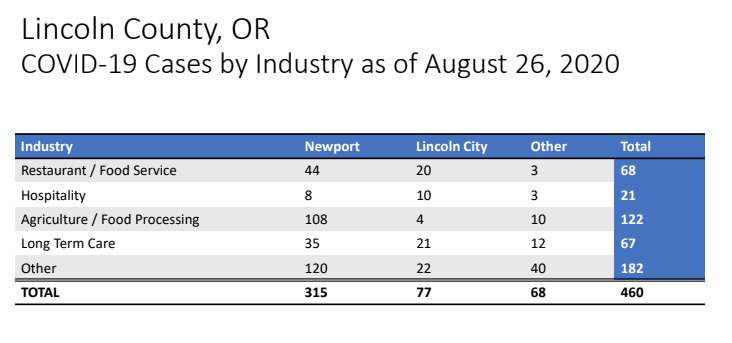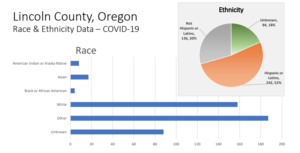
By QUINTON SMITH/YachatsNews.com
Lincoln County won’t be headed to Phase 2 of the state’s reopening plan for at least another three weeks.
Concerned about unclear state guidance and data on coronavirus cases in Lincoln County, commissioners voted unanimously Monday to push back reopening until Sept. 29.
The county had been scheduled to enter the phase and its looser restrictions on gatherings and businesses on Tuesday, Sept. 8, the day after the Labor Day holiday.
For such a big decision, the vote came near the end of an odd, often chaotic and rushed online meeting.

At it’s 3 p.m. Monday start, Chair Kaety Jacobson announced she had to leave at 4 p.m. to attend to a family issue, and promptly turned over the meeting to Commissioner Doug Hunt, who has steadfastly opposed moving into Phase 2.
Despite Jacobson’s 4 p.m. deadline, the first 19 minutes were taken up by a resolution and then presentation on declaring September “emergency preparedness” month. That helped lead to a rushed vote moments before Jacobson had to leave.
After the emergency preparedness resolution, Health Department Director Rebecca Austin tried to outline the latest coronavirus data, but was often stymied by miscommunication and meeting moderators’ ability to display county-produced charts.
Commissioners then heard from the co-chair of a health advisory committee which had written a letter a month ago recommending that the county delay going into Phase 2 until Sept. 21. But no other members of the public – for or against moving into Phase 2 – were invited to speak.
Just 7 counties still in Phase 1
Lincoln County is one of seven Oregon counties – and the only one on the Oregon coast — still in Phase 1. The others are Multnomah, Washington and Clackamas in the Portland area, and the eastern Oregon counties of Umatilla, Morrow and Malheur counties, which returned to Phase 1 after large outbreaks there.
The differences in allowed activities between Phase 1 and Phase 2 were once significant, but not so much since the governor in July re-instituted statewide restrictions on restaurants, bars and indoor and outdoor social gatherings.
The biggest change would be to allow entertainment venues to resume operation with capacity limits of 100 indoors and 250 outdoors, and allow theaters, cinemas, pools, bowling alleys to reopen.
Phase 2 also allows more professional offices to reopen, with precautions for keeping workers separate. And, cities could reopen their community facilities like offices, libraries and community or recreation centers.

Commissioners unclear on state data
Once again, commissioners were not clear Monday whether data from the Oregon Health Authority was conclusive enough to show that the rate of positive cases in Lincoln County – a key metric — were declining enough to win state approval.

OHA data released last week showed the county’s positivity rate was as low as 3.2 percent, well below the 5 percent rate cited by Gov. Kate Brown in late August to stop Lincoln County from moving to Phase 2.
But that single metric made public each Thursday relies on data that the OHA continues to update for another two weeks – making it unreliable for decisions only days later, said county health officials.
The last week for which the numbers are complete is the week ending Aug. 18. During that week 9.9 percent of all coronavirus tests in Lincoln County were positive.
Commissioners last week asked County Council Wayne Belmont to seek specific answers from the OHA on which metrics the county would be judged.
On Monday, Belmont said he did not get a formal letter, but only an email from OHA director Patrick Allen that indicated his agency needed to see a steady decline in the positivity metric and the county’s ability to meet six other “health indicators.”
The county’s positivity rate is declining, but is not below the 5 percent goal set by the governor.
The county currently meets five of the six indicators, Belmont said, and the state has previously said “there’s room for judgment” when it comes to whether a county has to meet all six. The state has allowed some counties – most notably Marion, Polk, Yamhill and Lane counties – to move into Phase 2 without showing they meet all of the health indicators.
But without clear direction and more solid, current data from the state, and warnings from Austen about Labor Day crowds at the coast, commissioners were reluctant to proceed to Phase 2 on Tuesday.
Belmont suggested waiting for the state’s weekly data updates Wednesday and scheduling another meeting Thursday to decide the issue. He also reminded commissioners that the county’s “24-hour hold” on entering motel rooms or vacation rentals would expire Tuesday, if the county moved into Phase 2.
With that, Hunt promptly made a motion to move the Phase 2 reopening and 24-hour hold regulation to Sept. 29. It passed 3-0.
The vote was a change for Jacobson and Commissioner Claire Hall, who had twice previously voted to proceed with having the county move into Phase 2.

Lincoln County unusual for coastal counties
With 466 COVID-19 cases and 13 deaths as of Tuesday, Lincoln County is an outlier among the seven counties along the Oregon coast. Only Lane County – which stretches from the Cascades to the Pacific and has a population eight times that of Lincoln County – has more cases, 717, but only six deaths.
Clatsop County has had 95 cases, Coos 116, Tillamook 38 and Curry 20 – and none have experienced a single coronavirus-related death, according to state data. Douglas County, which also stretches from the Cascades to the beach and has a population twice that of Lincoln County, has had just 117 cases and three deaths.
Eleven of Lincoln County’s coronavirus-related deaths have originated in long-term care facilities, which account for nearly half of all deaths across the state. And the county’s large number of positive cases stem largely from a massive early June outbreak at Pacific Seafood processing plants in Newport.

Case tracking also shows that more than 50 percent of Lincoln County’s cases have occurred in the Latino/Hispanic community, which makes up 10 percent of the county’s overall population. On Monday, Hunt cited that statistic as the “most powerful.”
Since June, Oregon State University has been using a $100,000 federal grant to monitor coronavirus in local wastewater treatment plants across the county. Its results indicate that only Newport continues to have a moderate level of the disease in the community. Commissioners have never discussed the program or heard updates and monitoring results that OSU sends to the Health Department.
The coronavirus sewer surveillance program, designed to be an early warning system for community or workplace outbreaks, is moving to 43 other cities across Oregon using a $1.2 million grant from the OHA.
The number of cases in Lincoln County appear to be slowly declining, according to state data. In August, the highest weekly total was 24 the week of Aug. 1-7, but 19 of those were from an outbreak at a long-term care facility in Lincoln City. There were 20 new cases for each of the weeks ending Aug. 14 and Aug. 20 and 14 new cases for the week ending Aug. 28.
Of the 466 cases since March in Lincoln County, there have been 23 people hospitalized.


